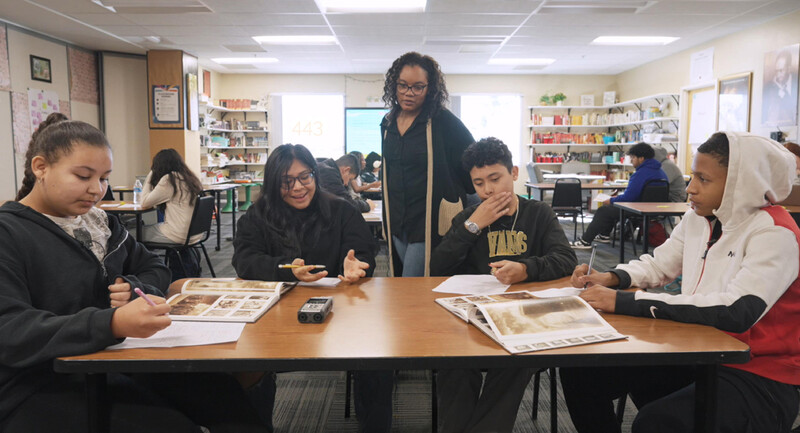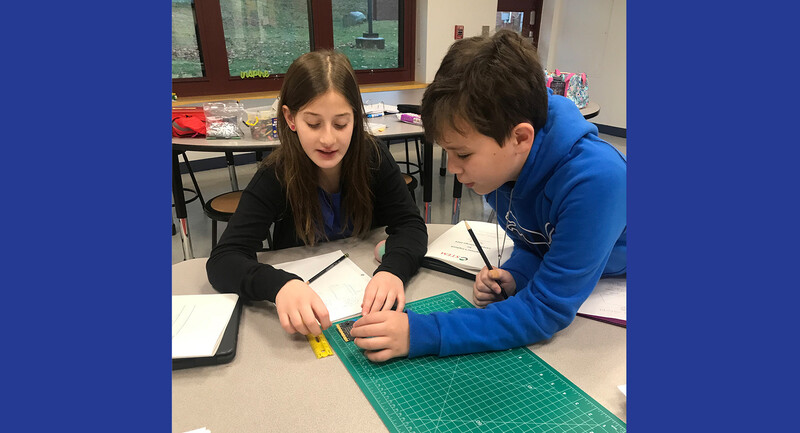It's a cold winter afternoon in Minnesota, and Kathy Mielke's biology class at Roseville Area High School seems sleepy and uninspired, so she sends a note to the office asking for permission to step out.
Soon after she leaves, a flamboyantly dressed woman in a tutu dances through the door, greeting the class loudly and breaking into a song about, of all things, DNA.
"Lady Mama," as she's known to the class, is Mielke's interpretation of Lady Gaga, and her songs—somewhat off-key and sometimes accompanied by students drumming, laughing, and singing along—come with a lesson about biology.
"Sometimes you just need to get their attention," says Mielke, a veteran teacher who is esteemed at Roseville, a suburban school between St. Paul and Minneapolis. "Science is fascinating, and I want them to see that."
Mielke uses humor in one way researchers and educators feel certain that it pays off—to get students engaged. It also can strengthen student-teacher relationships, decrease stress, and perhaps help students remember some facts, says John Banas, associate professor at the University of Oklahoma, who headed a team that reviewed 40 years of research on humor in the classroom. In a 2011 article for the journal Communication Education, he concluded that humor has "mixed results" in terms of its impact on learning, but it does help "create affinity," making teachers more influential and the content of their lessons more appealing.
"Working with middle schoolers would be incredibly difficult without humor," says Kelly Tate, who has a reputation for keeping her students smiling at Laurens-Marathon Middle School in Iowa. "I find that if I can get them to laugh, then I have their attention. I'll even settle for an age-appropriate eye roll."
Fun without the Bouncy Castle
Whether it's a simple pun to grab attention or a multilayered story introducing or reinforcing a lesson, humor should be developmentally appropriate and added with care, according to Ron Berk, former dean at the Johns Hopkins School of Education and author of the book Humor as an Instructional Defibrillator. He suggests a first-day discussion about classroom humor rules that discourages putdowns (even of famous people), profanity, vulgarity, sarcasm, stereotypes, or references to sensitive personal issues.
"It's a tool. There are times where we don't use it well, like hammering a nail with a screwdriver," says Fred Ende, assistant director of curriculum and instructional services at the Putnam Northern Westchester BOCES in New York. A funny story can get students' attention, while self-deprecating humor can reduce anxiety, but sarcasm or negativity can make an uncooperative group unravel further, he notes. "Experience and observation help us understand those nuances."
Sean O'Brien, an English teacher at West Ranch High School in California, says that because humor can also be overdone, educators have to find a sweet spot between learning and levity. Although "the atmosphere in a classroom can certainly be playful and joyful, it probably shouldn't just be fun the way a bouncy castle is."
O'Brien, whose former principal describes him as "hilarious," often uses incongruous elements to draw students in (such as having Romeo and Juliet on the set of The Maury Show or listing what Napoleon might post on Facebook), while highlighting parallels to their lives to sustain their attention.
"Mashing up the world of academia with the world the students live in is funny and memorable," O'Brien says. "If you don't believe me, I have one word for you: Hamilton."
Berk says the unexpected material that is usually found in humor promotes learning by "priming" the portions of the brain responsible for problem solving. Researchers advise teachers to make it clear when they are joking, however, because students tend to take jokes literally, which can prompt confusion.
Self-deprecating humor can also work in some classrooms, depending on the culture. Joan Young, ASCD author and teacher at Keys Middle School in California, compiles a "blooper book" of funny mistakes by her and, with their permission, her students. The examples not only teach them about fallibility and humility, but also reinforce lessons. One student's use of "slay" rather than "sleigh" and his cartoon about the mistake was useful in a discussion of homophones, for instance.
Engineering Entertainment
Young says that being funny—and involving students in the joke—can transform a teacher's relationship with the class. "Students are often hilarious, and if I laugh along, our sense of community builds and learning improves," she says.
To take some of the heat off herself, Young appoints a "classroom environment engineer" who shares a joke or story with the class, as needed. The student might also be responsible for shaking maracas or tapping a chime to renew class attention. The strategy works especially well when Young is not in the right frame of mind to be funny or feels that she has had students' attention for too long.
Don't despair if the jokes don't flow naturally, Young encourages. "Not everyone is an entertainer." Fortunately, plenty of resources are out there to help: cartoons, comics, stories, and videos.
Some teachers lighten the mood with a humor board or corner, or project a cartoon at the start of class. "Knowing they will see something funny right after recess inspires students to come in ready to engage," says Young, explaining how humor helps with transitions.
Mielke uses humor to redirect focus when behavior is off track. She often shifts the class to something funny and then, having reclaimed students' attention, returns to the topic. If she is unsuccessful at pulling them back in, she finds her firmer demeanor has more power because students are unaccustomed to experiencing it.
Giving Life to Lessons
Humor also offers a great way to shock life into a new lesson or a less than enticing topic. Maria Lunsford likes to ask her Algebra students at Argyle Middle School in Maryland to get creative on the last question of a classroom warm-up activity. She'll challenge them to draw things like two foods fighting, a lake monster, or simply "science" or to write about whether they would rather ride an ostrich or hippo to school. She even suggests they write a funny and encouraging message to themselves about how they'll do on a forthcoming test.
"It helps get them started, which is especially important when that task is an Algebra warm up," says Lunsford. "My walls are papered in kids' drawings."
O'Brien's high school lessons often begin with "curricular humor," featuring funny material related to the topic at hand. Many teachers rely on their own material, but a range of resources are available online, from sites like Pinterest, which has pages of school humor, to the "Cartoons for the Classroom" program with nearly 350 cartoons and accompanying lessons from the Association of American Editorial Cartoonists.
"We all pay attention to funny things, which makes us laugh and feel good," O'Brien says. "If I can connect that to learning—or, better yet, to the sometimes Byzantine and skull-crushingly dull minutiae of English grammar—then students are engaged going in, and the learning is sticky." Students want to be "in on" something, he adds—in the know, in the right groups, in the right clothes—so they listen to a joke to feel they will be part of a group understanding something funny. "Students relish the idea that they possess special knowledge."
Ende has no problem using "bad jokes" to gain students' attention. "I might say, 'I'm reading a book about black holes, and I can't help but feel I'm getting sucked in.'" He pauses to see what the response is, then asks a student who gets it why they are amused. "This requires students to listen closely to make the connection between black holes and their pull."
When Young taught elementary school, she often relied on short, funny videos or silly jokes as a hook. Her go-to sources for content-related humor and game show-like activities included Kahoot, TedEd, and the YouTube channels "Crash Course" and "SoulPancake."
Let's Eat Grandma
Banas and his colleagues' scan of the research found it is "difficult to form unequivocal conclusions regarding the relationship between humor and learning," but other researchers argue that humor excites the brain to make learning easier, funny facts are recalled more easily, and students felt they did better on tests with questions that made them laugh. Education humor specialist Mary Kay Morrison, president of the Association for Applied and Therapeutic Humor, says brain research shows humor "maximizes learning and strengthens memories."
Regardless, teachers say their lessons benefit from a little humor. Ende believes students "want to listen when we offer funny surprises in our instruction—a few well-placed puns, for example, in everything from a lecture, to a problem-based protocol, to a maker activity." And if they are listening, he says, they'll learn.
For O'Brien, humor pays off the most during reviews, when "a joke hinges on understanding the material," or when a funny mnemonic can be effective in reinforcing an idea. According to Banas, research shows humor works best when it is sandwiched between an explanation and repetition of a concept.
To reinforce the importance of a well-placed comma, Young shows students the sentences "Let's eat, Grandma" and "Let's eat Grandma." Tate, meanwhile, uses videos to reinforce her lessons and connect them with topics in students' lives: A lighthearted clip of a conflicted character from the movie Grease reminds students about persona in literature and the YouTube video "Too Late to Apologize: A Declaration" shows how key Revolutionary War figures dealt with their dilemmas, to the tune of One Republic's hit song.
Top 10 lists or multiple choice quizzes can remind students of key points, especially if they include outlandish responses in the mix. A Jeopardy-style game with quirky questions can reinforce lessons. Such strategies allow teachers to test jokes or approaches and adjust, reuse, or jettison them.
Even exit cards can be funny, O'Brien notes. He tells students to write down "three things their pencil would say to them" after that day's lesson or has them explain a joke that relates to the material covered. He's found that anticipation of the activity helps students pay more attention during class.
"Deliverables—whether they be assignments, tasks, projects, or homework—should be designed to [incorporate] humor," adds Ende. What he calls "task humor" in a video, skit, creative story, or a limerick "turns learners loose to build humor into their own work."
Test It Out
Berk is adamant about humor's effectiveness in teaching and even in testing. A student who becomes "mentally arthritic" won't test well, he explains.
At times, students receive bonus points from Mielke on tests if they can make her laugh, and O'Brien introduces a momentary break with a little wit. "You have five minutes until you have 30 minutes left," he'll say. "Stress inhibits mental function. A gentle joke lightens the mood, and students recover their concentration quickly."
Whether it's used to start class on the right foot, sandwiched between learning and re-learning, or thrown in to relieve tension in testing, humor is seen by many educators as a key instructional tool.








